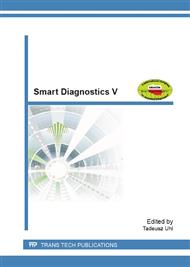[1]
R. Burdzik, Ł. Konieczny, Diagnosing of shock-absorbers of car vehicles at changeable pressure in tires, 4th International Congress on Technical Diagnostics, Olsztyn 2008, (in Polish).
Google Scholar
[2]
R. Burdzik, Ł. Konieczny, B. Śleziak, Wpływ zmian ciśnienia w ogumieniu na wyniki badań amortyzatorów samochodu osobowego, XXXV Ogólnopolskie Sympozjum Diagnostyka Maszyn, Węgierska Górka 2008, (in Polish).
Google Scholar
[3]
R. Burdzik, J. Warczek, Wpływ ciśnienia w ogumieniu i obciążenia pojazdu na ocenę skuteczności układu hamulcowego w warunkach stacji kontroli pojazdów, Zeszyty Naukowe Pol. Śl. S. Transport z. 66 15-24 (2010) (in Polish).
Google Scholar
[4]
R. Burdzik, Z. Stanik, J. Warczek, Method of assessing the impact of material properties on the propagation of vibrations excited with a single force impulse, Archives of Materials and Metallurgy 57(2) (2012) 409—416.
DOI: 10.2478/v10172-012-0040-5
Google Scholar
[5]
W. Batko, W. Cioch, E. Jamro, Monitoring system for grinding machine of turbine-engine blades, Journal of Polish CIMAC 2(2) (2007) 13–18.
Google Scholar
[6]
R. Burdzik, Ł. Konieczny, Diagnosing of shock-absorbers of car vehicles at changeable pressure in tires, Diagnostyka 3(51) (2009) 27-32.
Google Scholar
[7]
R. Burdzik, Monitoring system of vibration propagation in vehicles and method of analysing vibration modes. J. Mikulski (Ed.): TST 2012, CCIS 329, Springer, Heidelberg, 2012, pp.406-413.
DOI: 10.1007/978-3-642-34050-5_46
Google Scholar
[8]
R. Burdzik, Ł. Konieczny, B. Łazarz, Influence of damping characteristics changes on vehicles vibration research, 19th International Congress on Sound and Vibration, Vilnius Lithuania, 2012.
Google Scholar
[9]
R. Burdzik, Ł. Konieczny, B. Łazarz, The influence of changing vehicle tire stiffness on phase angle, 19th International Congress on Sound and Vibration, Vilnius Lithuania, 2012.
Google Scholar
[10]
E. Jamro, M. Wielgosz, S. Bieniasz, W. Cioch, FPGA – ARM heterogeneous system for high speed signal analysis, Solid State Phenomena 180 (2012) 207—213.
DOI: 10.4028/www.scientific.net/ssp.180.207
Google Scholar
[11]
M. Jasinski, S. Radkowski, Use of the higher spectra in the low-amplitude fatigue testing, Mechanical Systems And Signal Processing 25(2) (2011) 704-716.
DOI: 10.1016/j.ymssp.2010.06.001
Google Scholar
[12]
W. J. Staszewski, Ruztamreen bin Jenal, A. Klepka, M. Szwedo, T. Uhl, A Review of Laser Doppler Vibrometry for Structural Health Monitoring Applications, in T. Uhl (Eds.), Structural Health Monitoring II, Key Engineering Materials 518 1-15 (2012).
DOI: 10.4028/www.scientific.net/kem.518.1
Google Scholar
[13]
R. Tadeusiewicz, Sieci neuronowe, Akademicka Oficyna Wydawnicza, Warszawa 1993 (in Polish).
Google Scholar
[14]
S. Osowski, Sieci neuronowe w ujęciu algorytmicznym, WNT, Warszawa 1996 (in Polish).
Google Scholar
[15]
P. Czech, Identification of leakages in the inlet system of an internal combustion engine with the use of Wigner-Ville transform and RBF neural networks, J. Mikulski (Ed.): TST 2012, CCIS 329, Springer, Heidelberg, 2012, pp.414-422.
DOI: 10.1007/978-3-642-34050-5_47
Google Scholar
[16]
B. Irzyniec, Automatyczna klasyfikacja ciśnienia w ogumieniu podczas badań diagnostycznych amortyzatorów pojazdów samochodowych, praca inżynierska napisana pod kierunkiem dr. inż. R. Burdzika, Politechnika Śląska, Wydział Transportu, Katowice 2009 (in Polish).
Google Scholar
[17]
J. Tuma, Gearbox noise and vibration prediction and control, International Journal of Acoustics and Vibration vol. 14 issue 2 (2009) 99-108.
DOI: 10.20855/ijav.2009.14.2242
Google Scholar
[18]
R. Farana, R. Wagnerova, Sliding mode controls of complex control systems, Mine Planning and Equipment Selection. RK. Singhal, BP. Singh (Ed.) 2001 11-17.
Google Scholar


